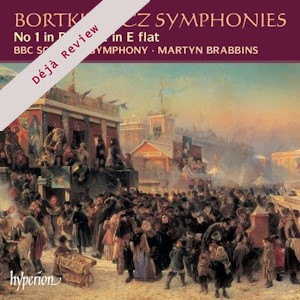
Déjà Review: this review was first published in September 2002 and the recording is still available.
Sergei Bortkiewicz (1877-1952)
Symphony No. 1 in D Aus Meiner Heimat (1935-36) [39.10]
Symphony No. 2 in E flat (1937) [32.35]
BBC Scottish SO/Martyn Brabbins
rec. 2002, City Hall, Glasgow, UK
Hyperion CDA67338 [72]
The shade of Sergei Bortkiewicz is in the debt of Bhagwan Thadani, Raymond Oke and Malcolm Henbury-Ballan just as much as that of Gustav Jenner is to Professor Horst Heussner (see the recent CPO boxed set of the Jenner chamber music on CPO 999 699-2). I owe it to Mr Thadani that the sound of these two works was not completely unfamiliar to me. I enthusiastically reviewed Mr Thadani’s and Mr Oke’s CD of the sequenced simulation of these two symphonies back in 1999. That was a case of faute-de-mieux but even so the dynamic and vivid qualities of this music shone through the ersatz sound quality.
Mr Thadani has recorded privately the complete surviving piano music of Kharkov-born Bortkiewicz and many of the orchestral scores. His and Raymond Oke’s simulations using computer programmes and sampled orchestral sounds have been the key to opening up these scores to today’s audiences.
The First Symphony (From my homeland) declares, through its title, a remembrance of his Russian homeland recalled from the leafy chaussées of Vienna. The work is fluently Tchaikovskian with much aching nostalgia, upheaval and flighty comedy. There are Glazunov-like tumbling high spirits in the scherzo and in the Allegro Vivace finale. The scherzo resonates with the pizzicato movement of Tchaikovsky’s Fourth, with his Rococo Variations and with the finale of the Third Suite. Russian Orthodox chant broods gloweringly through the Adagio which also takes time to include reminiscences of the nostalgic yearning of the first movement. The finale synthesises a wonderfully aspiring Slavonic theme, typically Borodin in its topography, and marries it with the Miaskovskian minatory voices of the abruptly imperious opening of the work. This movement triumphantly rings the changes in a metamorphic tumult of Glazunov-like victory (symphonies 5 and 8), imperial splendour (1812) and Tchaikovskian melodrama (symphony 4).
The blindfold test might well place this symphony circa 1900 (if not earlier). On the evidence of the title you may expect music which is relaxed and nostalgic but prepare yourself for drama too; especially in the outer two of the four movements. This is most assuredly nostalgic stuff but the edges are unsoftened, the drama is vivid and excitement is built by a musician whose reverence for Tchaikovsky is clear. The title may prepare you for the pictorialism of Raff or Rubinstein; the music is quite other.
Bortkiewicz proves himself the Tchaikovsky disciple again in the Second Symphony. This is even more urgently impassioned, sullen and angry than its predecessor. It is often exciting, drawing on the wellsprings of Tchaikovsky (Symphonies 4-5 and Francesca) without being a pallid facsimile. The andante sostenuto is akin to the final movement of Tchaikovsky 6 and builds a lapel-gripping atmosphere. The finale sustains the excitement but its angst reacts with the same impulsive Borodin-like music as appears in the finale of No. 1.
The silky sheen of the strings is pretty well put across by the Scots; not that I cannot imagine it sounding even more sumptuously radiant in the hands of say Ormandy and the Philadelphians or Mravinsky and the Leningrad Phil had there been world enough and time in the 1960s. The Scottish brass are gloriously hoarse and insistent.
Brabbins handles this music very well indeed and surely we can look for him to be at the helm when Hyperion record Bortkiewicz’s Piano Concertos 2 and 3, the meaty Tchaikovskian Cello Concerto and the much lighter Violin Concerto (the latter a forgotten travelling companion to the Glazunov).
This disc has sprung onto the retailers’ shelves with astounding speed. The recordings were only made in February this year!
For those who use mind-maps you can place this disc as a further dactyl off the limbs that carry recordings of Borodin’s Second Symphony, Tchaikovsky’s 4 and 5, Glazunov’s 4, 5, 6 and 8, Kopylov and Arensky (better than Arensky and quite as good as the neglected Kopylov on ASV) and Rachmaninov 2 and 3.
Documentation is what you would expect from this source: encyclopaedic, well informed and laced with the adventurous spirit of an investigative archivist. The author is Malcolm Henbury-Ballan, an Indiana Jones of the world’s music libraries. He it was who, by a chance discovery, traced the scores to the Fleisher Collection in Philadelphia where, more than half a century ago, Bortkiewicz had deposited the scores and parts for safe-keeping.
‘I can’t wait to hear this with a real orchestra.’ So I wrote in 1999. Now we have my wish and handsomely delivered too. Roll on the later Bortkiewcz instalments … for surely they will come!
Rob Barnett
Help us financially by purchasing from



















